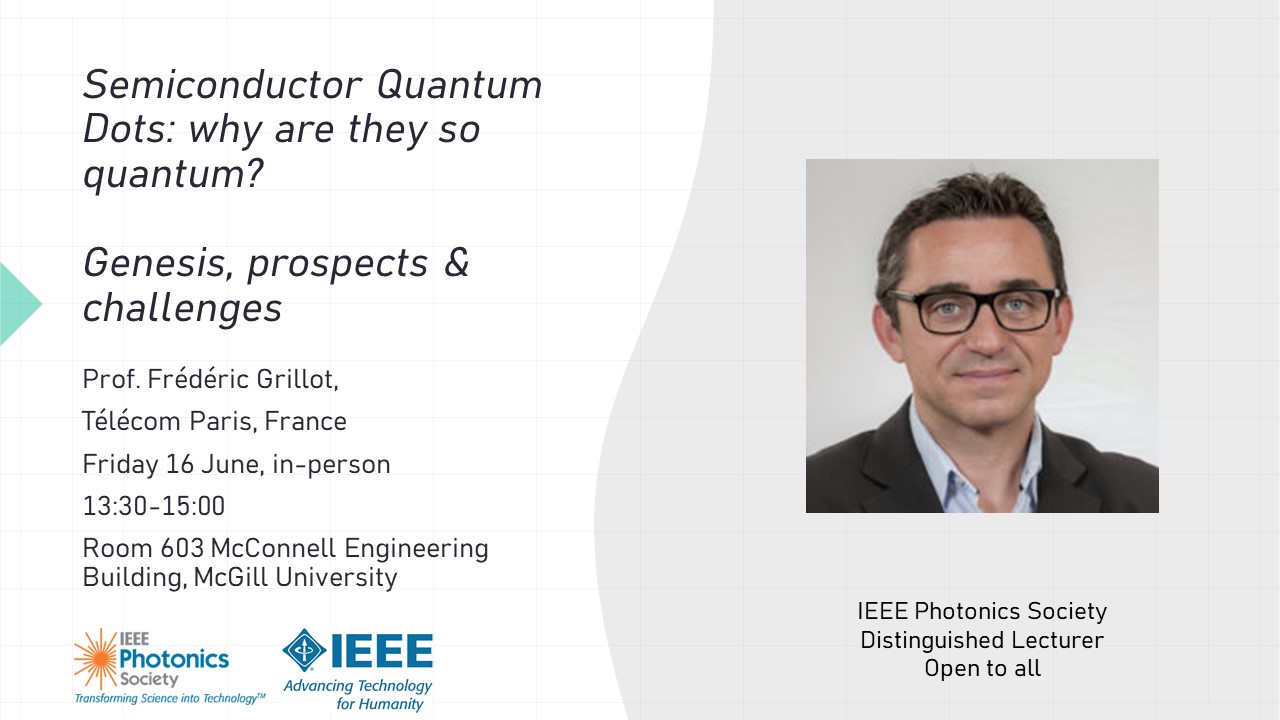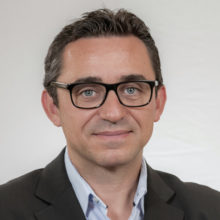IEEE Distinguished Lecture - "Semiconductor Quantum Dots, why are they so quantum? Genesis, prospects & challenges" by Prof. Frédéric Grillot

Abstract : Semiconductor nanostructures with low dimensionality like quantum dots are one the best attractive solutions for achieving high performance photonic devices. When one or more spatial dimensions of the nanocrystal approach the de Broglie wavelength, nanoscale size effects create a spatial quantization of carriers along with various other phenomena based on quantum mechanics. Thanks to their compactness, great thermal stability and large reflection immunity, semiconductor quantum dot lasers are very promising candidates for low energy consumption and isolation free photonic integrated circuits. When directly grown on silicon, they even show a four-wave mixing efficiency much superior compared to the conventional quantum well devices. This remarkable result paves the way for achieving high-efficiency frequency comb generation from a photonic chip. Quantum dot lasers also exhibit a strong potential for applications in optical routing and optical atomic clock.
Last but not least, a quantum dot single photon source is a building block in secure communications, and therefore can be applied to quantum information processing for applications such as quantum computers. This lecture will review the recent findings and prospects on nanostructure based light emitters made with quantum-dot technology. Many applications ranging from silicon-based integrated solutions to
quantum information systems will be presented. In addition, the lecture will highlight the importance of nanotechnologies on industry and society especially for shaping the future information and communication society.
Date and Time
Location
Hosts
Registration
-
 Add Event to Calendar
Add Event to Calendar
- Room: MC603, McConnell Engineering building, 3480 University Street, H3A 0E9
- Montreal, Quebec
- Canada
Speakers
 Prof. Frédéric Grillot of Télécom Paris, France
Prof. Frédéric Grillot of Télécom Paris, France
Abstract : Porous semiconducting nitrides are effectively a new class of semiconducting material, with properties distinct from the monolithic nitride layers from which devices from light emitting diodes (LEDs) to high electron mobility transistors are increasingly made. The introduction of porosity provides new opportunities to engineer a range of properties including refractive index, thermal and electrical conductivity, stiffness and piezoelectricity. Quantum structures may be created within porous architectures and novel composites may be created via the infiltration of other materials into porous nitride frameworks. A key example of the application of porous nitrides in photonics is the fabrication of high reflectivity distributed Bragg reflectors (DBRs) from alternating layers of porous and non-porous GaN. These reflectors are fabricated from epitaxial structures consisting of alternating doped and undoped layers, in which only the conductive, doped layers are electrochemically etched. Conventionally, trenches are formed using a dry-etching process, penetrating through the multilayer, and the electrochemical etch then proceeds laterally from the trench sidewalls. The need for these trenches then limits the device designs and manufacturing processes within which the resulting reflectors can be used. We have developed a novel alternative etching process, which removes the requirement for the dry-etched trenches, with etching proceeding vertically from the top surface through channels formed at naturally-occurring defects in the crystal structure of GaN. This etch process leaves an undoped top surface layer almost unaltered and suitable for further epitaxy. This new defect-based etching process provides great flexibility for the creation of a variety of sub-surface porous architectures on top of which a range of devices may be grown. Whilst DBR structures enable improved light extraction from LEDs and the formation of resonant cavities for lasers and single photon sources, recent development also suggest that thick, subs-surface porous layers may enable strain relaxation to help improve the efficiency of red microLEDs for augmented reality displays. Meanwhile, the option of filling pores in nitride layers with other materials provides new opportunities for the integration of nitrides with emerging photonic materials, such as the hybrid-perovskite semiconductors, with perovskites encapsulated in porous nitride layers demonstrating greatly improved robustness against environmental degradation.
Biography:
Frédéric Grillot is a Full Professor at Télécom Paris and a Research Professor at the University of New-Mexico. His current research interests include, but are not limited to, advanced quantum confined devices using III-V compound semiconductors, quantum dots quantum dashes, light-emitters based on intersubband transitions, non-classical light, nonlinear dynamics and optical chaos in semiconductor lasers systems as well as microwave and silicon photonics applications.
Dr. Grillot has made outstanding technical contributions in optics, photonics and optoelectronics. In particular he has intensively contributed to the development of quantum dot lasers enabling their utilization as future active devices with superior performance. His recent achievements on epitaxial quantum dot lasers on silicon are very important for the next-generation of optical sources for isolator-free integrated photonic circuits. Among his recent major achievements, he also reported the first private free-space communications using quantum cascade laser’s chaos as well as giant pulses emission and multigigabits operation with mid infrared quantum cascade devices. Overall, his research is highly relevant both to the advancement of science and to the emerging practical applications, such as the use of lasers and optoelectronics in computer technology, as well as in more traditional areas such as optical communications.
Dr. Grillot has served diligently and successfully to the general optics community and Optica in particular as an Associate Editor of Optics Express. As of now, he has published 130 journal articles, 3 book chapters, and many contributions in major international conferences and workshops. Dr. Grillot is also a Fellow Member of the SPIE as well as a Senior Member of Optica and the IEEE Photonics Society. As the new Deputy Editor, Dr. Grillot will strongly contribute to promote and support the further development of Optics Express as the ideal platform to report new scientific findings and exchange new ideas of the large optics community.

